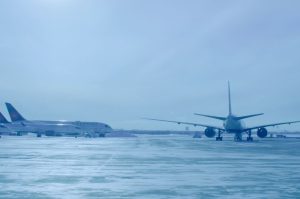De-Ice and Air Canada to trial chemical-free de-icing
 De-Ice has named Air Canada as its first customer to use its electromagnetic technology to de-ice aircraft more sustainably.
De-Ice has named Air Canada as its first customer to use its electromagnetic technology to de-ice aircraft more sustainably.
The technology will be used on Airbus A320-family with tape-like strips attached to the exterior of the aircraft, which connect to the proprietary electronics inside the aircraft.
When activated by the pilot, the system generates high-frequency current, causing electrons on the surface of the aircraft to jiggle, generating heat, melting snow and ice during the boarding process so the aircraft is ice-free and ready for take-off by the time it is pulled back from the gate.
The De-Ice system uses a semi-conductor called gallium nitride to generate a high-frequency current using devices that weigh an order of magnitude less than traditional equipment.
De-Ice says before gallium nitride, transistors capable of generating high-frequency current were made of silicon, which is too inefficient to be used for this application.
The technology means aircraft can be de-iced without using de-icing fluids and it reduces carbon dioxide (CO2) emissions.
Alexander Bratianu-Badea, Co-Founder of De-Ice, said: “De-Ice is proud to introduce our product to the world with Air Canada. Flight delays and the excess carbon emissions caused by chemical-based de-icing will be a thing of the past.”
Murray Strom, Senior Vice President Flight Operations and Maintenance at Air Canada, added: “Not only will De-Ice technology be positive for our customers by reducing delays related to the conventional method of aircraft ice removal, but the environmental benefits of chemical-free de-icing and associated lower fuel consumption are in line with Air Canada’s commitment to a net zero emissions goal from all global operations by 2050.”

